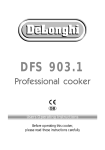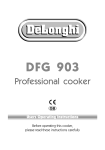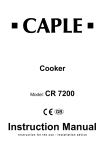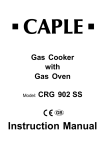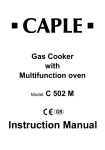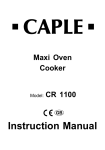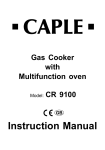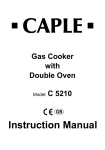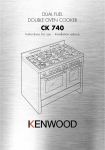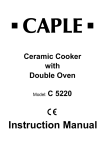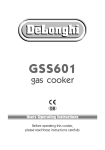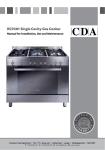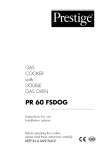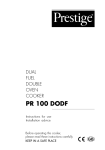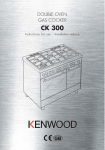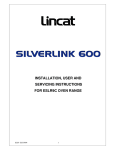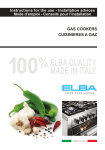Download DeLonghi OVEN WITH ELECTRONIC CONTROLS Operating instructions
Transcript
DFS 901SS Professional cooker GB Users Operating Instructions Before operating this cooker, please read these instructions carefully Dear Customer Thank you for choosing one of our appliances which has been carefully designed and built by our specialist staff and thoroughly tested to satisfy your cooking requirement. We suggest that you read this Instruction Booklet so that you will understand fully how to operate the appliances. Please keep the booklet handy. You may wish to refer to it at a later date. De Longhi 2 Contents Model DFS 901SS Page Number Introduction . . . . . . . . . . . . . . . . . . . . . . . . . . . . . . . . . . . . . . . . . . . . . . . . . . . . . 4 Features and technical data . . . . . . . . . . . . . . . . . . . . . . . . . . . . . . . . . . . . . . . . . 5 Control panel . . . . . . . . . . . . . . . . . . . . . . . . . . . . . . . . . . . . . . . . . . . . . . . . . . . . 6 Electronic clock/alarm . . . . . . . . . . . . . . . . . . . . . . . . . . . . . . . . . . . . . . . . . . . . . 7 How to use the hob burners . . . . . . . . . . . . . . . . . . . . . . . . . . . . . . . . . . . . . . . . 8 How to use the multifunction oven . . . . . . . . . . . . . . . . . . . . . . . . . . . . . . . . . . .10 Important notes . . . . . . . . . . . . . . . . . . . . . . . . . . . . . . . . . . . . . . . . . . . . . . . . . .16 After sales service . . . . . . . . . . . . . . . . . . . . . . . . . . . . . . . . . . . . . . . . . . . . . . . . .16 Do’s and do not’s . . . . . . . . . . . . . . . . . . . . . . . . . . . . . . . . . . . . . . . . . . . . . . . . .17 Care and maintenance . . . . . . . . . . . . . . . . . . . . . . . . . . . . . . . . . . . . . . . . . . . . .18 For the installer Location . . . . . . . . . . . . . . . . . . . . . . . . . . . . . . . . . . . . . . . . . . . . . . . . . . . . . . . 23 Fitting the adjustable feet . . . . . . . . . . . . . . . . . . . . . . . . . . . . . . . . . . . . . . . . . . .24 Stability bracket . . . . . . . . . . . . . . . . . . . . . . . . . . . . . . . . . . . . . . . . . . . . . . . . . .26 Provision for ventilation . . . . . . . . . . . . . . . . . . . . . . . . . . . . . . . . . . . . . . . . . . . .27 Gas installation . . . . . . . . . . . . . . . . . . . . . . . . . . . . . . . . . . . . . . . . . . . . . . . . . . .28 Conversion to LPG . . . . . . . . . . . . . . . . . . . . . . . . . . . . . . . . . . . . . . . . . . . . . . . .30 Lubrication of the gas taps . . . . . . . . . . . . . . . . . . . . . . . . . . . . . . . . . . . . . . . . . .33 Electrical installation . . . . . . . . . . . . . . . . . . . . . . . . . . . . . . . . . . . . . . . . . . . . . . .34 3 Introduction Congratulations on your purchase of this Delonghi gas cooker which has been carefully designed and produced to give you many years of satisfactory use. Before using this appliance it is essential that the following instructions are carefully read and fully understood. We would emphasise that the installation section must be fully complied with for your safety to ensure that you obtain the maximum benefits from your appliance. Assembling the backguard 1. Insert the side supports S and D into the backguard B (see fig. 1) 2. Insert the backguard group into the support guides in the cooker 3. The backguard can be removed for cleaning or fixed with a screw through the hole C. D B S C Fig. 1 This cooker has been designed, constructed and marketed in compliance with: - safety requirements of EEC Directive “Gas” 90/396; - safety requirements of EEC Directive “Low voltage” 73/23; - protection requirements of EEC Directive “EMC” 89/336; - requirements of EEC Directive 93/68. 4 Features and technical data Gas burners 1. 2. 3. 4. 5. 6. Multifunction oven Double-ring burner (PB) Semi-rapid burner (SR) Rapid burner (R) Auxiliary burner (A) Semi-rapid burner (SR) Auxiliary burner (A) 3,45 kW 1,90 kW 2,95 kW 1,00 kW 1,90 kW 1,00 kW – Bottom element – Top element – Grill element – Circular element – Fan motor – Oven lamp – Rotisserie 2050 W 1250 W 2200 W 2500 W 25 W 15 W 4W – Usable oven volume 100 dm3 4 5 3 6 1 2 Identification label Fig. 2 When you open the bottom oven door the indentification label is at the bottom right hand side. 5 Control panel Fig. 3 A U T O 1 2 3 4 5 6 7 CONTROL PANEL - Controls description 1. 2. 3. 4. 5. 6. 7. 8. 9. 10. 6 Electronic clock/alarm Multifunction oven switch knob Multifunction oven thermostat knob Front left burner control knob Rear left burner control knob Front central burner control knob Rear central burner control knob Rear right burner control knob Front right burner control knob Rotisserie control knob 8 9 10 How to use the electronic clock The electronic programmer is a device with the following functions: – 24 hours clock with illuminated display – Timing of oven cooking with automatic switch-off (max. 99 minutes). Electronic clock Upon immediate connection of the oven or after a mains failure, three zeros will flash on the programmer panel. To set the clock it is necessary to push the button and then, within 7 seconds, the or button until you have set the correct time. The clock will show zero after a mains failure. Attention: When the programmer display shows three flashing zeros the oven cannot be switched on. The oven can be switched on when the symbol is shown in the display. Setting the frequency of the alarm sound The selection from 3 possibilities of sound can be made by pressing the button. A U T O Fig. 4 Cooking with automatic switch-off The aim of this function is to automatically stop the cooking after a pre programmed time, for a maximum period of 99 minutes. To set the cooking time, push the or button until you obtain the desired time in the display. The symbol AUTO will be shown in the display. Then you adjust the oven thermostat knob according to the required temperature. The oven will immediately start to operate and will work for the pre programmed time. The display shows the count down. Clock time can be displayed by pressing the button. Once the time has elasped, the oven will switch off automatically, the symbol AUTO will go off and an intermittent buzzer, lasting 7 minutes, will start; this can be stopped by pressing the button. Important: Before the buzzer is stopped switch off the oven manually. To cancel the cooking program at any time press the and buttons together and release the button first. Electronic alarm The programmer can be used as an alarm only for a maximum period of 99 minutes. To set the alarm, push the or button until you obtain the desired time in the display. Once the time has elasped, an intermittent buzzer, lasting 7 minutes, will start; this can be stopped by pressing the button. Attention: If the bottom oven is switched on when the buzzer starts, it will be automatically switched off. For it to operate furtherly you have to stop the buzzer by pressing the button. 7 How to use the hob burners Hob burners Each hob burner is controlled by a separate gas tap operated by a control knob (fig. 5) which has 3 positions marked on the control panel, these are: – Symbol ● : tap closed (burner off) – Symbol : High (maximum) – Symbol : Low (minimum) Push in and turn the knob anti-clockwise to the selected position. Low High Fig. 5 To turn the burner off, fully rotate the knob clockwise to the off position: ●. The maximum setting of the control tap is for boiling, the minimum setting is for slow cooking and simmering. All working positions must be choosen between the maximum and minimum setting, never between the maximum setting and the “OFF” position. Electric ignition The sparks generated by the electrodes close to the burners will ignite the choosen burner. Whenever the lighting of the burners is difficult due to peculiar conditions of the gas features or supply, it is advised to repeat the ignition with the knob on “minimum” position. Lighting of the hob burners To ignite the burner, the following instructions are to be followed: 1) Lightly press and turn the knob anti-clockwise, and position the knob indicator to the symbol printed on the control panel (fig. 5). 2) Press the knob to operate the electric ignition; or, in the case of a mains failure light the burner with a match or lighted taper. 3) Adjust the burner according to the setting required. 8 Choice of burner The burner must be choosen according to the diameter of the pans and energy required. Burners Pan diameter Auxiliary Semi-rapid Rapid Double-ring 16 cm 16 ÷ 22 cm 20 ÷ 24 cm up to 30 cm Fig. 6 Saucepans with handles which are excessively heavy, in relationship to the weight of the pan, are safer as they are less likely to tip. Pans which are positioned centrally on burners are more stable than those which are offset. It is far safer to position the pan handles in such a way that they cannot be accidentally knocked. When deep fat frying fill the pan only one third full of oil. DO NOT cover the pan with a lid and DO NOT leave the pan unattended. In the unfortunate event of a fire, leave the pan where it is and turn off all controls. Place a damp cloth or correct fitting lid over the pan to smother the flames. DO NOT use water on the fire. Leave the pan to cool for at least 30 minutes. Correct use of double-ring burner The flat-bottomed pans are to be placed directly onto the pan-support. To use the WOK you need to place the proper stand in order to avoid any faulty operation of the double-ring burner (Fig. 6a - 6b). WRONG Fig. 6a CORRECT Fig. 6b 9 How to use the Multifunction oven OPERATING PRINCIPLES Heating and cooking in the MULTI-FUNCTION oven are obtained in the following ways: a. by normal convection The heat is produced by the upper and lower heating elements. b. by forced convection A fan sucks in the air contained in the oven muffle, which sends it through the circular heating element and then sends it back through the muffle. Before the hot air is sucked back again by the fan to repeat the described cycle, it envelops the food in the oven, provoking a complete and rapid cooking. It is possible to cook several dishes simultaneously. c. by semi-forced convection The heat produced by the upper and lower heating elements is distributed throughout the oven by the fan. d. by radiation The heat is radiated by the infra red grill element. e. by radiation and ventilation The irradiated heat from the infra red grill element is distributed throughout the oven by the fan. Fig. 7 Fig. 8 FUNCTION SELECTOR KNOB (Fig. 7) THERMOSTAT KNOB (Fig. 8) Rotate the knob clockwise to set the oven for one of the following functions. This only sets the cooking temperature and does not switch the oven on. Rotate clockwise until the required temperature is reached (from 50 to 225°C). 10 OVEN LIGHT By setting the knob to this position, only the oven light comes on (15 W). It remains on in all the cooking modes. TRADITIONAL CONVECTION COOKING The upper and lower heating elements come on. The heat is dispersed by natural convection and the temperature must be set to between 50° and 225°C via the thermostat knob. The oven must be preheated before cooking. Recommended for: Food that requires the same degree of cooking both inside and out, for example roasts, spare pork ribs, meringues etc. GRILLING The infrared grill element comes on. The heat is dispersed by radiation. Set the thermostat knob to between 50° and 200°C. Always grill with the oven door closed. For cooking hints, see the chapter “USE OF THE GRILL”. Recommended for: Intense grilling, browning, cooking au gratin and toasting etc. Do not grill for longer than 30 minutes at any one time on full heat (200°C). Caution: the oven door becomes very hot during operation. Keep children well out of reach. DEFROSTING FROZEN FOODS Only the oven fan comes on. Use with the thermostat knob set to “0” - other positions have no effect. The food is thawed by ventilation without heating. Recommended for: Quick thawing of frozen foods; one kg requires approximately 1 hour. Thawing times vary according to the quantity and type of food to be thawed. 11 HOT AIR COOKING The circular element and fan come on. The heat is dispersed by forced convection and the temperature can be regulated to between 50° and 225°C via the thermostat knob. The oven does not require preheating. Recommended for: Food which has to be well-cooked outside and soft or rosy inside, for example lasagne, lamb, roast beef, whole fish etc. VENTILATED GRILL COOKING The infrared grill element and the fan come on. The heat is dispersed mainly by radiation and the fan then distributes it all over the oven. Use with the door closed. The temperature can be regulated via the thermostat knob to between 50° and 175° max. The oven must be preheated for approximately 5 minutes. For cooking hints, see the chapter “GRILLING AND COOKING AU GRATIN. Recommended for: Grilling where quick browning on the outside is required to keep the juices in. For example: veal steaks, chops, hamburgers etc. Do not grill for longer than 30 minutes at any one time on full heat (175°C). Caution: the oven door becomes very hot during operation. Keep children well out of reach. MAINTAINING TEMPERATURE AFTER COOKING OR SLOWLY HEATING FOODS The upper heating element, the circular element and the fan come on. The heat is dispersed by forced convection with greater intensity in the upper part. The temperature can be set to between 50° and 140°C via the thermostat knob. Recommended for: Keeping food warm after any type of cooking. Slow heating of cooked food. CONVECTION COOKING WITH VENTILATION The upper and lower heating elements come on and the fan. The heat coming from above and below is dispersed by convection with ventilation. The temperature can be set to between 50° and 225°C via the thermostat knob. Recommended for: Voluminous dishes and large quantities which require the same degree of cooking both inside and out, for example rolled roasts, turkey, roast legs, cakes etc. 12 COOKING ADVICE STERILIZATION Sterilization of foods to be conserved, in full and hermetically sealed jars, is done in the following way: a. Set the switch to position . b. Set the thermostat knob to position 185 °C and preheat the oven. c. Fill the dripping pan with hot water. d. Set the jars onto the dripping pan making sure they do not touch each other and the door and set the thermostat knob to position 135 °C. When sterilization has begun, that is, when the contents of the jars start to bubble, turn off the oven and let cool. REGENERATION Set the switch to position and the thermostat knob to position 150° C. Bread becomes fragrant again if wet with a few drops of water and put into the oven for about 10 minutes at the highest temperature. SIMULTANEOUS COOKING OF DIFFERENT FOODS The MULTI-FUNCTION oven set on position consents a simultaneous heterogeneous cooking of different foods. Different foods such as fish, cake and meat can be cooked together without mixing the smells and flavors together. This is possible since the fats and vapors are oxidized while passing through the electrical element and therefore are not deposited onto the foods. The only precaution to follow are: – The cooking temperatures of the different foods must be as close to as possible, with a maximum difference of 20° - 25 °C. – The introduction of the different dishes in the oven must be done at different times in relation to the cooking times of each one. The time and energy saved with this type of cooking is obvious. 13 GRILLING AND “AU GRATIN” Grilling may be done without the roasting jack on position of the switch, because the hot air completely envelops the food that is to be cooked. Set the thermostat to position 175 °C and after having preheated the oven, simply place the food on the rack. Close the door and let the oven operate with the thermostat on position 175 °C, until grilling is done. Adding a few dabs of butter before the end of the cooking time gives the golden “au gratin” effect. Do not grill for longer than 30 minutes at any one time on full heat (200°C). Caution: the oven door becomes very hot during operation. Keep children well out of reach. ROASTING To obtain classical roasting, it is necessary to remember: – that it is advisable to maintain a temperature between 180° and 200 °C. – that the cooking time depends on the quantity and the type of foods. USE OF THE GRILL Preheat the oven for about 5 minutes. Introduce the food to be cooked, positioning the rack as close to the grill as possible. The dripping pan should be placed under the rack to catch the cooking juices and fats. Grilling with the oven door closed. Do not grill for longer than 30 minutes at any one time on full heat (200°C). Caution: the oven door becomes very hot during operation. Keep children well out of reach. 14 Rotisserie (Fig. 10) This is used for spit roasting under the grill and comprises: – an electric motor fitted to the rear of the oven – a stainless steel skewer provided with slide-out heatless handgrip and two sets of adjustable forks – a skewer support to be fitted in the middle runner. The rotisserie motor is operated by the oven switch (Fig. 9). Fig. 9 Use of the rotisserie – Insert the tray into the lowest rack holders of the oven and insert the rod support into the intermediate rack holders. – Put the meat to be cooked onto the rod, being careful to secure it in the center with the special forks. – Insert the rod into the side gear opening “P” – Remove the grip “H” by turning it to the left. – Insert completely the rotisserie support; the shaft “S” must be inserted in the spit motor collar “G”. The rotation direction of the rotisserie can be either clokwise or counter-clockwise. S P G H Fig. 10 15 Important notes Installation, and any demonstration, information or adjustments are not included in the warranty. The cooker must be installed by a qualified person in accordance with the Gas Safety (Installation and Use) (Amendment) Regulations 1990 and the relevant building/l.E.E Regulations. Failure to install the appliance correctly could invalidate any manufacturers warranty and lead to prosecution under the above quoted regulation. In the UK C.O.R.G.I registered installers are authorised to undertake the installation and service work in compliance with the above regulations. All Comet authorised installers are C.O.R.G.I. registered. Attention The appliance gets very hot, mainly around the cooking areas. It is very important that children are not left alone in the kitchen when you are cooking. Safety guard The glass on the oven door reaches high temperatures during operation. For child safety, a door guard can be fitted to prevent contact with the hot glass. The door guard is supplied as an accessory at an additional cost if required. To order telephone accessories direct 0113 2310523. After Sales Service If you should require After Sales Service please contact your nearest COMET Service Centre. For technical information telephone the Comet Customer Help Line 0113 2793520. 16 Do’s and do not’s Do’s and do not’s • Do always grill with the oven door closed. • Do read the user instructions carefully before using the cooker for first time. • Do allow the oven to heat for one and a half hours, before using for the first time, in order to expel any smell from the new oven insulation, without the introduction of food. • Do clean your oven regularly. • Do remove spills as soon as they occur. • Do always use oven gloves when removing food shelves and trays from the oven. • Do not allow children near the cooker when in use. • Do not allow fat or oils to build up in the oven trays, or oven base. • Do not place cooking utensils or plates directly onto the oven base. • Do not grill food containing fat without using the grid. • Do not cover the grilling grid with aluminium-foil. • Do not use the oven tray for roasting. • Do not place hot enamel parts in water. Leave them to cool first. • Do not allow vinegar, coffee, milk, saltwater, lemon or tomato juice to remain in contact with enamel parts (inside the oven and on the oven tray). • Do not use abrasive cleaners or powders that will scratch the surface of the stainless steel and the enamel. • Do not attempt to repair the internal workings of your oven. • Do remove the protective film before the first use. • Fire risk! Do not store flammable material in the oven and in the dishwarmer compartment. For your safety The product should only be used for its intended purpose which is for the cooking of domestic foodstuffs. Under no circumstances should any external covers be removed for servicing or maintenance except by suitably qualified personnel. 17 Care and maintenance Important: As a safety measure, before you start cleaning the cooker be sure to disconnect it from the mains supply. Do not use a steam cleaner because the moisture can get into the appliance thus make it unsafe. Cleaning the hob Spillage on the hob can usually be removed by a damp soapy cloth. More obstinate stains can be removed by rubbing gently with a soapy scouring pad or mild household cleaner. Burners They can be removed and washed only with soapy water. Detergents can be used but must not be abrasive or corrosive. Do not use abrasive sponges or pads. Do not put in dishwasher. After each cleaning, make sure that the burner-caps, as well as the burners, have been well wiped off and CORRECTLY POSITIONED. It is essential to check the correct position of the burner-caps as the least displacement from the housing may cause serious problems. Burner-cap ring partially drilled 18 Burner-cap ring fully drilled Gas taps If a tap becomes stiff, do not force; contact your local COMET Service Centre. Flexible tube From time to time, check the flexible tube connecting the gas supply to the cooker. It must be always in perfect condition; in case of damage arrange for it to be replaced by a C.O.R.G.I. registered installer. Cleaning oven parts after use The oven interior and the chromium plated shelves can be cleaned by damp soapy cloth. Obstinate stains can be removed with nylon scouring pads and gentle, non-abrasive, liquid cleaner. Provided the oven is wiped over immediately after roasting, only the minimum of cleaning should be necessary. Stainless steel Clean with a suitable products. Always dry accurately. 19 Removal of the inner glass door panel – The inner glass door panel can easily be removed for cleaning by unscrewing the four screws (fig. 11). – When re-assembly ensure that the inner glass is correctly positioned and do not over tighten the screws. Fig. 11 Dishwarmer compartment – The dishwarmer compartment is accessible through the pivoting panel. Fig. 12 Assembling and removing the side racks Hang up the wires racks on the oven walls (fig. 13) Slide the required grid or tray into the guides Fig. 13 20 Oven tray The oven tray must be correctly placing on its wire shelf support (fig. 14) then insert into the side runners (fig. 15) Fig. 14 Fig. 15 Changing the oven light 1. Disconnect the electrical power supply (for example, by switching off the main power switch). 2. Unscrew the light cover 3. Fit a new bulb. 4. Refit the cover. Note: Use only bulbs designed to resist up to 300°C with the following characteristics: 15 W, 230 V, type E-14. Spare bulbs can be ordered from Accessories direct telephone 0113 2310523. 21 Removing the oven door Fig. 16a Please operate as follows: ● ● ● ● Open the door completely. The swivel retainers of the rh and lh hinges (fig. 16a) are hooked onto the metal bar above them (fig. 16b). Lift the oven door slightly. The noch on the bottom of the hinge will disengage (fig. 16c). Now pull the oven door forwards off the appliance. Release both hinge sections from the slots (fig. 16d). Fig. 16b Door assembly ● Grip the door (as indicated in figure 16) and refit it in reverse order of removing procedure. Fig. 16c Fig. 16d Fig. 16 22 FOR THE INSTALLER Location This cookers has type “2/1” overheating protection so that it can be installed next to a cabinet. The furniture walls adjacent to the cooker must be made of material resistant to heat. The veneered syntetical material and the glue used must be resistant to a temperature of 120°C in order to avoid ungluing or deformations. The cooker may be located in a kitchen, a kitchen/diner or bed-sitting room but not in a room containing a bath or shower. Curtains must not be fitted immediatly behind appliance or within 500 mm of the sides. It is essential that the cooker is positioned as stated below. 500 mm 800 mm The cooker must be installed by a qualified technician and in compliance with a local safety standard. 300 mm 500 mm Fig. 17 23 Fitting the adjustable feet The adjustable feet must be fitted to the base of the cooker before use. Rest the rear of the cooker an a piece of the polystyrene packaging exposing the base for the fitting of the feet. Fig. 18 24 WARNING When raising cooker to upright position always ensure two people carry out this manoeuvre to prevent damage to the adjustable feet (fig. 19). WARNING Be carefull: do not lift the cooker by the door handle when raising to the upright position (fig. 20). Fig. 19 WARNING When moving cooker to its final position DO NOT DRAG (fig. 21). Lift feet clear of floor (fig. 19). Levelling the cooker The cooker may be levelled by screwing the lower ends of the feet IN or OUT (fig. 22). Fig. 20 Fig. 21 Fig. 22 25 Stability bracket We recommend a stability bracket is fitted to the cooker. The type shown in fig. 23 can be purchased from most plumbers merchants and do it yourself (D.I.Y.) shops. Existing slot in rear of cooker Brackets Fig. 23 Dotted line showing the position of cooker when fixed 3 Outline of cooker backplate at the engagement slot Wall fixing Floor fixing Dimension is in millimetres 26 Provison for ventilation The room containing the cooker should have an air supply in accordance with BS.5540: Part 2: 1989. All rooms require an openable window or equivalent while some rooms require a permanent vent in addition to the openable window. The cooker should not be installed in a bed-sitting room, of volume less than 21 m3. Where a DOMESTIC COOKER is installed in a room or internal space, that room or internal space shall be provided with a permanent opening which communicates directly with outside air and is sized in accordance with table below. In domestic premises the permanent opening shall be an air vent. If there are other fuel burning appliances in the same room, BS.5540: Part 2: 1989 should be consulted to determine the requisite air vent requirements. If the cooker is installed in a cellar or basement, it is advisable to provide an air vent of effective area 100 cm2, irrespective of the room volume. MINIMUM PERMANENT OPENING FREE AREA FOR FLUELESS APPLIANCE > 20 m3 Openable window or equivalent also required Nil cm2 Yes Room volume Type of appliance Maximum appliance rated input limit < 5 m3 Domestic oven, hotplate, grill or any combination thereof. None 100 cm2 5 m3 to 10 11 m3 to m3 20 m3 50 (❊) cm2 Nil cm2 (❊) If the room or internal space containing these appliances has a door which opens directly to outside, no permanent opening is required. 27 Gas installation IMPORTANT NOTE This appliance is supplied for use on NATURAL GAS only and cannot be used on any other gas without modification. This appliance is manufactured for conversion to LPG and is supplied with a conversion kit. The cooker must be installed by a qualified person in accordance with the Gas Safety (Installation and Use) (Amendment) Regulation 1990 and the relevant building/l.E.E. Regulations. The following British Standards should be used as reference when installing this appliance. BS6172 1990, BS5440 part 2 1989 and BS6891 1988. Failure to install the appliance correctly could invalidate any manufacturers warranty and lead to prosecution under the above quoted regulation. In the UK C.O.R.G.I registered installers are authorised to undertake the installation and service work in compliance with the above regulations. 28 Gas connection The installation of the cooker to Natural Gas or LP Gas must be carried out by a qualified gas engineer. Installer shall take due account of the provisions of the relevant British Standards Code of Practice, the Gas Safety Regulations and the Building Standards (Scotland) (Consolidation) Regulations issued by the Scottish Development Department. Installation to Natural Gas Installation to Natural Gas must conform to the Code of Practice, etc. The supply pressure for Natural Gas is 20 mbar. Installation to LP Gas This appliance must only be connected to LPG after an LPG conversion kit has been fitted, (see pages from 30 to 32). When operating on Butane gas a supply pressure of 28-30 mbar is required. When using Propane gas a supply pressure of 37 mbar is required. The installation must conform to the relevant British Standards. Warning: Only a qualified gas engineer, also with technical knowledge of electricity should install the cooker. He should observe the Regulations and Codes of Practice governing such installation of gas cookers. Note: It is recommended that the gas connection to the cooker is installed with a flexible connecting tube made to BS 5386. Gas connection The gas supply must be connected to the gas inlet which is located at the left or the right hand rear of the appliance (see figure 24). The pipe do not cross the cooker. To screw the connecting tube operate with two spanners (see fig. 25). The unused end inlet pipe must be closed with the plug interposing the gasket. After connecting to the mains, check that the coupling are correctly sealed, using soapy solution, but never a flame. Plug Fig. 24 Fig. 25 29 Conversion to LPG 1 - Injectors replacement of top burners To replace the injectors it is necessary to lift the hobtop and proceed as follows: – Remove pan-supports and burners from the hobtop. – Remove the backguard “E”. – Unscrew the two screws “B” and remove the sockets (Fig. 26). – Unscrew the two screws “C” and remove the two side trims and joints pulling upwards. – Pull forwards the hobtop to release it, then lift following arrow “D” (Fig. 26) – Hold the hobtop open by a support. – Fully raise the adjusting air tube A (fig. 27) in order to easily reach the injector. – By an angle 7 spanner, remove the injector from its housing and replace it by the proper one according to the kind of gas (see following tables - page 32). B E B D Fig. 26 C C 2 -Adjusting of primary air of the top burners By operating the screw “M”, reset the air adjuster “A” according to the instructions see “Injector table”, where the distance between injector and air adjuster is recommended (in mm). Before lowering the hob top, set the burners on their sites and light them in order to check whether the flames are correct, as per the specifications given in the next page. In case of uncorrect flame, lift or lower the air adjuster. 30 M J A Fig. 27 Flame faulty in primary air Flame correct Flame with excess primary air long, yellow and trembling clear interior blue cone short and sharp too blue interior cone tending to detach CAUSE air regulating tube, too closed correct distance of the tube air regulating tube, too open 3 - Adjusting of the minimum of the top burners Considering that in the minimum position the flame must have a length of about 4 mm and must remain lit even with a quick turn from the maximum position to that of minimum. The flame adjustment is done in the following way: – Turn on the burner – Tum the tap to the MINIMUM position – Take off the knob – With a small flat screwdriver turn the screw inside the tap rod to the correct regulation (fig. 28). Normally for LPG, tighten up the regulation screw. Fig. 28 31 Table for the choice of the injectors GB Nominal Reduced Power Power [kW] [kW] By-pass [1/100 mm] Ø injector Auxiliary (A) 1,00 0,30 27 50 3* Semi-rapid (SR) 1,90 0,38 29 67 5,7 * Rapid (R) 2,95 0,60 39 83 fully open * Double-ring 3,45 0,85 47 92 fully open * [1/100 mm] Ring opening [mm] G 20 20 mbar By-pass [1/100 mm] adjustable BURNERS Cat: II 2H3+ G 30 - 28-30 mbar G 31 - 37 mbar Ø injector [1/100 mm] Ring opening [mm] 72 1* 100 2* 125 3* 135 5* * = Reference value INCREASE OF AIR NECESSARY FOR GAS COMBUSTION (2 m3/h x kW) BURNERS Air necessary for combustion [m3/h] Auxiliary (A) 2,00 Semi-rapid (SR) 3,80 Rapid (R) 5,90 Double-ring 6,90 32 Lubrication of the gas taps Should it be found that the gas taps are difficult to turn, most probably they require lubrication. This should be done immediately this problem has been noticed as follows. – Turn off the gas supply to cooker. – Remove all control knobs. – Remove control panel. – Unscrew the two screws which mounts the gas tap to the gas rail. – Remove the circlip and ignition switch from the front of the gas tap. – Disassemble the body of the tap. – Clean cone and housing with cloth soaked in thinners or similar, re-grease as required with a special gas tap grease. – Put cone back in housing and rotate a number of times. Remove cone and take off any excess grease, making sure that gas passages are clear. – Reassemble all pieces in opposite order to disassembly. 33 Electrical installation For your safety please read the following information: This appliance must be installed by a qualified technician according with the current local regulations and in compliance with the manufacturer instructions. All electrical wiring must be in compliance with the appropriate IEE regulations and carried out by a qualified electrician . Before installing the cooker the electricity must be turned off. Warning! This appliance must be earthed This oven must be supplied via a suitable double pole isolating switch. The electrical connection must be connected to the terminal block “B” (fig. 29) and must only be carried out by a qualified electrician. A cable of the correct rating of this appliance must be use type H05RR-F section 3x1,5 mm2. Connecting the mains cable – Remove the screws securing the cover “A” (fig. 29) on the rear of the cooker. – Remove the screws from the cable clamp “D” (fig. 29) and feed the cable through the clamp. – Connect the live and neutral wires. – Take up any slack in the cable and secure with cable clamp “D”. – Replace cover “A”. 230 V PE N L B A Fig. 29 34 D L1 N PE (L2) Fig. 30 35 ß10 DFS 901SS cooker Ed. 6 - Cod. 1101442




































